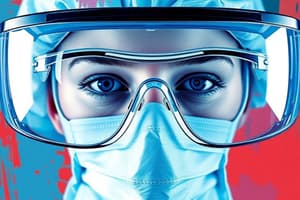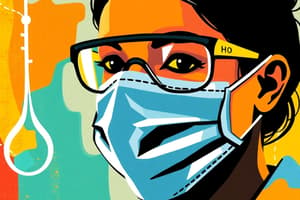Podcast
Questions and Answers
What should you do if an accident occurs in the lab?
What should you do if an accident occurs in the lab?
- Leave the lab and seek help from a classmate
- Fix the issue yourself before reporting
- Wait until class is over to inform the teacher
- Report the incident to the teacher immediately (correct)
Which of the following is NOT a recommended practice in the lab?
Which of the following is NOT a recommended practice in the lab?
- Touching and feeling the equipment (correct)
- Wearing goggles and gloves
- Wearing closed toe shoes
- Keeping your area neat
What is one reason for wearing Personal Protective Equipment (PPE) in the lab?
What is one reason for wearing Personal Protective Equipment (PPE) in the lab?
- To protect against chemicals and accidents (correct)
- To prevent distraction
- To comply with fashion trends
- To look professional
Where should personal items be kept during lab activities?
Where should personal items be kept during lab activities?
What is the importance of knowing where safety equipment is located?
What is the importance of knowing where safety equipment is located?
It is acceptable to use personal items in the lab area as long as they are kept neat.
It is acceptable to use personal items in the lab area as long as they are kept neat.
Personal Protective Equipment (PPE) includes goggles and gloves.
Personal Protective Equipment (PPE) includes goggles and gloves.
You should taste lab chemicals to understand their properties better.
You should taste lab chemicals to understand their properties better.
Knowing the locations of safety equipment is an important part of lab safety.
Knowing the locations of safety equipment is an important part of lab safety.
Students should always listen to their teacher and follow instructions in the lab.
Students should always listen to their teacher and follow instructions in the lab.
Flashcards are hidden until you start studying
Study Notes
Lab Safety Rules
- Always listen to the teacher and adhere strictly to instructions given during laboratory sessions.
- Dress appropriately for the lab environment: wear long pants, closed-toe shoes, and keep hair tied back to prevent accidents.
- Use Personal Protective Equipment (PPE) such as goggles and gloves to ensure personal safety while conducting experiments.
- Maintain a neat workspace; clean up after lab activities and refrain from bringing food or personal items to the lab.
- Utilize equipment and chemicals strictly as directed to ensure safe and effective results.
- Do not touch, sniff, or taste any materials in the lab to avoid hazardous exposure.
- Report all accidents or spills to the teacher immediately to address safety concerns promptly.
- Familiarize yourself with the location of emergency safety equipment including eyewash stations, safety showers, fire extinguishers, and First Aid kits for quick access in emergencies.
Lab Safety Rules
- Always listen to the teacher and adhere strictly to instructions given during laboratory sessions.
- Dress appropriately for the lab environment: wear long pants, closed-toe shoes, and keep hair tied back to prevent accidents.
- Use Personal Protective Equipment (PPE) such as goggles and gloves to ensure personal safety while conducting experiments.
- Maintain a neat workspace; clean up after lab activities and refrain from bringing food or personal items to the lab.
- Utilize equipment and chemicals strictly as directed to ensure safe and effective results.
- Do not touch, sniff, or taste any materials in the lab to avoid hazardous exposure.
- Report all accidents or spills to the teacher immediately to address safety concerns promptly.
- Familiarize yourself with the location of emergency safety equipment including eyewash stations, safety showers, fire extinguishers, and First Aid kits for quick access in emergencies.
Studying That Suits You
Use AI to generate personalized quizzes and flashcards to suit your learning preferences.




